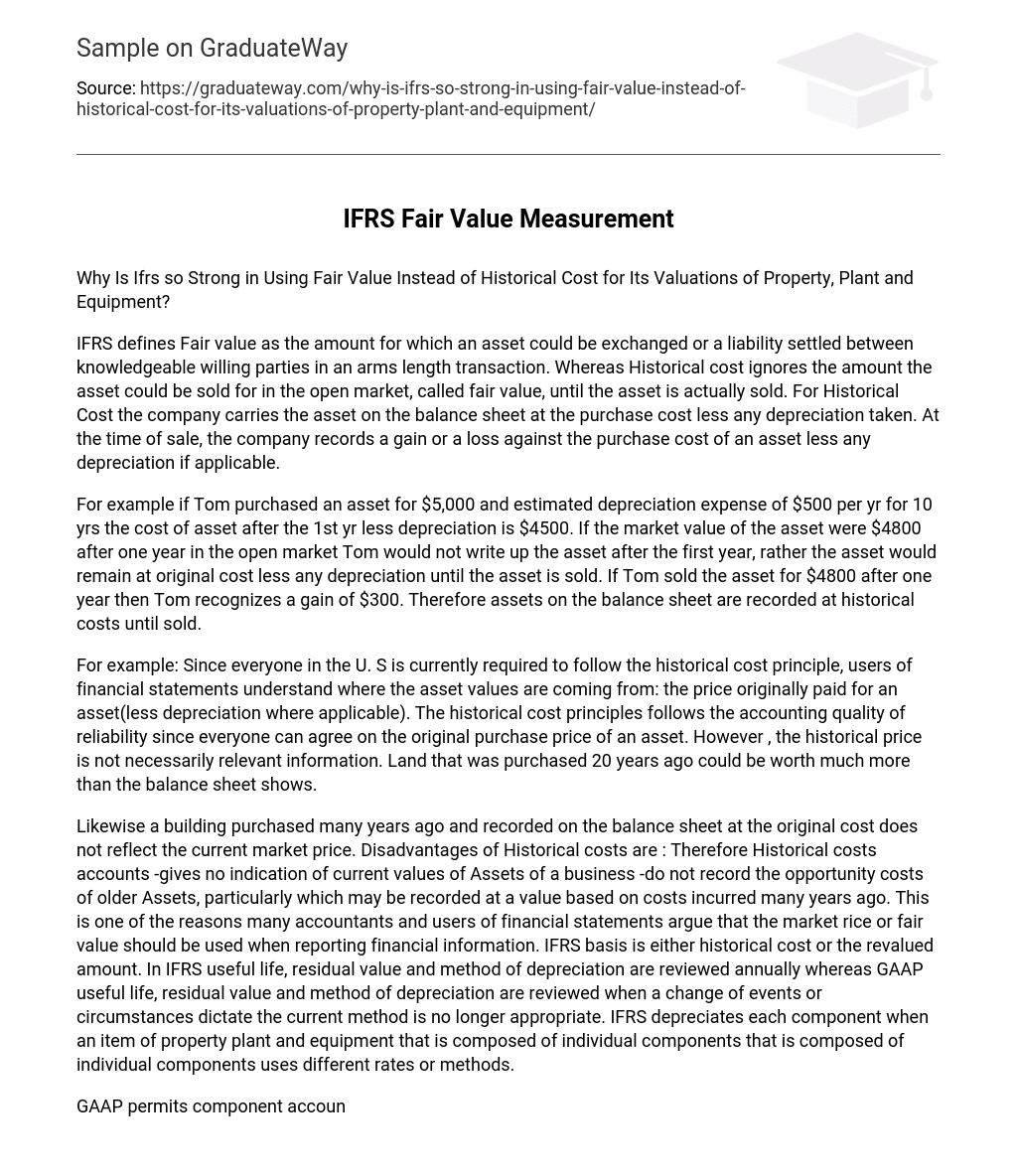Why Is Ifrs so Strong in Using Fair Value Instead of Historical Cost for Its Valuations of Property, Plant and Equipment?
IFRS defines Fair value as the amount for which an asset could be exchanged or a liability settled between knowledgeable willing parties in an arms length transaction. Whereas Historical cost ignores the amount the asset could be sold for in the open market, called fair value, until the asset is actually sold. For Historical Cost the company carries the asset on the balance sheet at the purchase cost less any depreciation taken. At the time of sale, the company records a gain or a loss against the purchase cost of an asset less any depreciation if applicable.
For example if Tom purchased an asset for $5,000 and estimated depreciation expense of $500 per yr for 10 yrs the cost of asset after the 1st yr less depreciation is $4500. If the market value of the asset were $4800 after one year in the open market Tom would not write up the asset after the first year, rather the asset would remain at original cost less any depreciation until the asset is sold. If Tom sold the asset for $4800 after one year then Tom recognizes a gain of $300. Therefore assets on the balance sheet are recorded at historical costs until sold.
For example: Since everyone in the U. S is currently required to follow the historical cost principle, users of financial statements understand where the asset values are coming from: the price originally paid for an asset(less depreciation where applicable). The historical cost principles follows the accounting quality of reliability since everyone can agree on the original purchase price of an asset. However , the historical price is not necessarily relevant information. Land that was purchased 20 years ago could be worth much more than the balance sheet shows.
Likewise a building purchased many years ago and recorded on the balance sheet at the original cost does not reflect the current market price. Disadvantages of Historical costs are : Therefore Historical costs accounts -gives no indication of current values of Assets of a business -do not record the opportunity costs of older Assets, particularly which may be recorded at a value based on costs incurred many years ago. This is one of the reasons many accountants and users of financial statements argue that the market rice or fair value should be used when reporting financial information. IFRS basis is either historical cost or the revalued amount. In IFRS useful life, residual value and method of depreciation are reviewed annually whereas GAAP useful life, residual value and method of depreciation are reviewed when a change of events or circumstances dictate the current method is no longer appropriate. IFRS depreciates each component when an item of property plant and equipment that is composed of individual components that is composed of individual components uses different rates or methods.
GAAP permits component accounting and does not require it. IFRS exercises revaluation on property, plant and equipment when Fair Value can be measured reliably. Revaluations on method, useful and residual value are reviewed at the annual reporting date. GAAP does not exercise revaluation of PP & E. IFRS defines real value as the current net selling price for an asset of disposal age in the condition expected at the end of its useful life. Residual value is only adjusted downward.
GAAP defines the residual value of property as the discounted present value of expected proceeds on future disposal which may be adjusted up or down. The effects of Fair Value Measurement – The amount of tax paid when taxes are based on Net worth. It enhances consistency and comparability in financial reporting . Companies using FV of accounting rely more on debt financing than companies that use historical cost, so companies using the fair value to signal asset liquidation values to their creditors.
It also offers greater transparency and investor understanding of financial institutions. The objective of IAS 16 is to prescribe the accounting treatment for PPE so that the users of the financial statements can understand about an entity’s investment in its property, plant and equipment and the changes in such investment. The principle issues are: -The timing of recognition of asset -the determination of their carrying amounts -the depreciation charges and impairment losses to be recognized in relation to them
PPE uses cost model and Revaluation model Cost model . Measurement after recognition in Cost model depreciation cost over useful life and in Revaluation model revaluation amount over useful life where depreciation at revalued amount to the useful life. In conclusion it can be said that IAS 16 provides disclosures and application of PPE. Its main objective is to provide a timely recognition of asset, determination of carrying amounts and depreciation charges to be recognized over its useful life.
Disadvantages of Historical costs are that it does not provide the current market price of an asset and it does not recognize the opportunity cost of older assets that was purchased years ago. Fair value measurement will have its effect on taxes where taxes are calculated on the current net worth of assets. It will provide a transparency of financial statements that is the True and Fair View of the PPE. Consistency and comparability will also be enhanced. The debt equity financing will help those companies that want to borrow for further investments and the creditors will know the approximate figure for liquidation.





